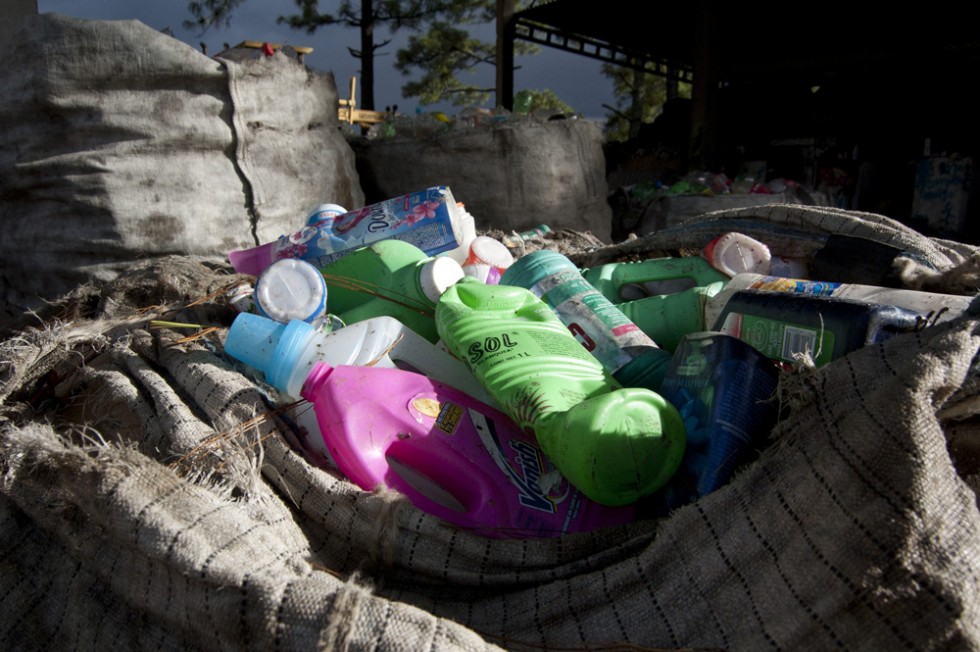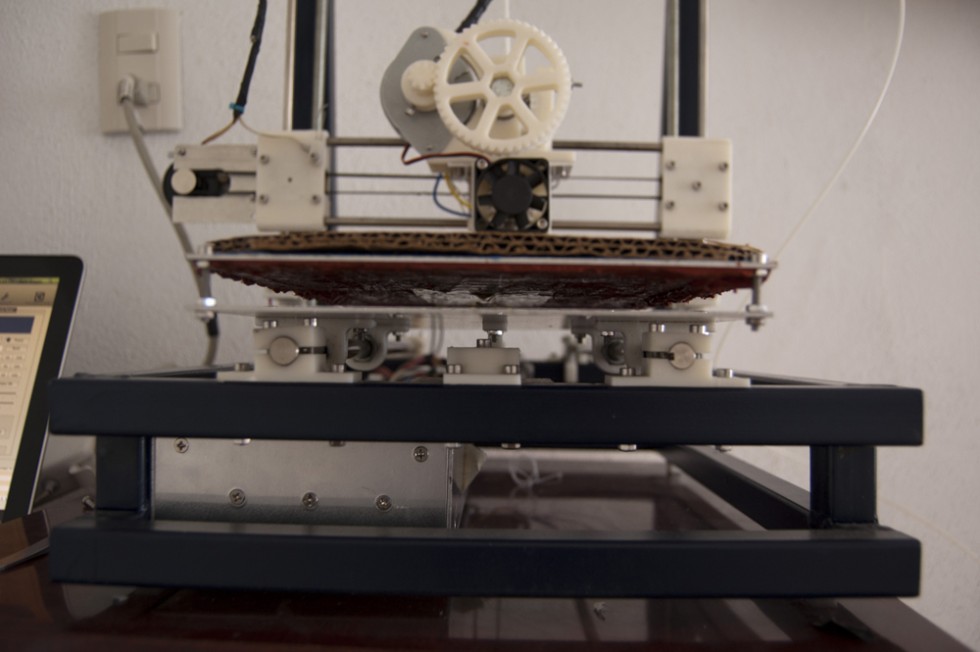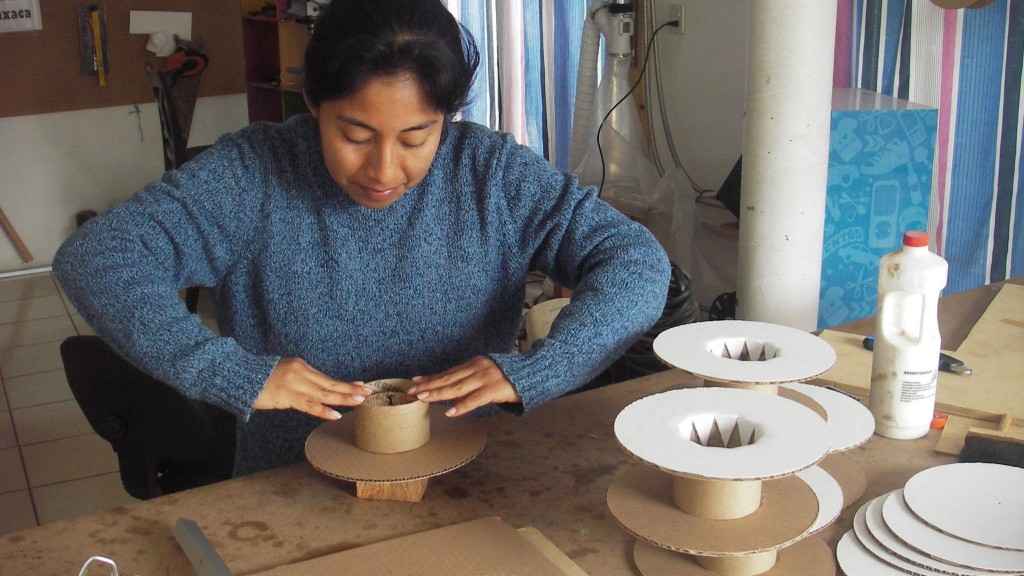On a steep road on the outskirts of Oaxaca de Juárez, Mexico, a low buzz and plastic fumes emanate from a white house. A ribbed white paper tube snakes out of a window on the building, exhaling a light smoke which mixes with fumes from nearby open-air cooks and the sooty exhaust of rumbling, unmuffled bus engines. Inside, the tube is attached to a machine that’s gobbling plastic flakes—which can come from used drink bottles—through a funnel also made from a plastic drink bottle. At the other end of the machine, a spinning wheel draws out the fresh-melted polymer into a black filament just three millimeters wide and value hundreds of times what it was worth in in bottle form.

This is Oaxaca’s FabLab and the office of Nahielly Cervantes and David Díaz, two engineers born and raised here who are trying to bring the promise of the 3D printing boom to a place known more for its ancient mole recipes and hand-woven textiles. In much of Mexico, the supply chains for soft drinks and plastic bottles reach farther into the hinterlands than do those for healthy food or steady jobs, and small towns such as San Miguel del Río are struggling to balance economic and environmental stewardship. Oaxaca is the third-poorest state in Mexico, making that especially challenging. So it came as little surprise to Cervantes and Díaz when residents of San Miguel approached them at a FabLab event this spring with a question: what can we do with all this plastic waste we’re collecting?
San Miguel and its regional capital, Ixtlán de Juárez, were already sorting their plastic and trucking it out, but they were earning very little from it. To Cervantes and Díaz, the answers were clear. Grind it up before selling it, they told the residents of San Miguel. That makes transport easier. Even better, melt it into filament for 3D printers and sell it. Or best of all, use some of that filament to print things you’d otherwise have to pay to import.
That’s the premise of FabLab’s relationship with San Miguel and Ixtlán: to help the towns deal with their plastic problem in an unusual—but valuable—way.
A Fab Idea
Since 2003, about when the first FabLab was founded, 3D printing has grown from an extreme do-it-yourself project to a growing industry that sells off-the-shelf kits and parts online. Alongside that growth, hardware hobbyists have turned into community organizers. Physicist Neil Gershenfeld at the Massachusetts Institute of Technology (MIT) in Cambridge, Massachusetts, one of the FabLab originators, wrote the book Fab on the concept, outlining the bare necessities for a FabLab. The FabLab movement’s organizers now promote a standard blueprint for community fabrication laboratories with enough machinery, parts, and open software to produce prototypes for entrepreneurs.
Cervantes and Díaz first heard about FabLabs when a Dutch advocate visited Oaxaca. He explained that not all facilities are MIT-scale, and in Europe, many are more independent and flexible. Some take a more educational bent, offering classes on everything from metal-working to software coding. Others limit their production capacity to match smaller budgets.

Heartened, Cervantes, Díaz, and others in Oaxaca arranged to start their own FabLab in early 2013 amidst green-hued limestone churches and brightly painted colonial buildings. At the time, they didn’t have a clear idea of all the things they might do with it, but they figured they’d start with a public space where Oaxacans could get their hands on computers and hardware. They began acquiring and building machines and offering classes to the public. “We arrived at a moment when we realized there was less to talk about and more to do,” Cervantes recalls.
In the meantime, 3D printer makers and users began selling parts to one another. Technical standards began to emerge. Expectations rose as the industry transformed from one dominated by bleeding-edge hobbyists to those with more commercial intentions. Many people began demanding narrower tolerances and more reliability, especially those who paid for their parts.
In one way, 3D printers are similar to inkjet printers: they push a liquefied material onto a flat surface. Unlike inkjet printers, after a 3D printer has printed its first layer, the printing head moves up a tiny amount and returns to print another layer on top, then another, and so on until the job is complete. To ensure accurate deposition, the plastic filament, just like ink, needs to be consistent. It cannot be too thick or too brittle, or the printing will go awry. Virgin plastic makes controlling the production process easy. Anything else takes a lot of trial and error.
Value Added
Inside the FabLab, Díaz crouches next to the extruder by the window. The extruder melts down plastic flakes and pulls them into filament. Alongside him is engineering consultant Matt Rogge, who is visiting the FabLab from Seattle. Díaz grunts, “I think it needs more speed.” Rogge hovers alongside him and reads numbers on the machine’s side. Their plastic is not emerging at industry-standard thickness.
Rogge had purchased the flakes from a supplier in Oregon. Rogge, a minimalist, had purchased only enough to ensure the custom extruder that he, Cervantes, and Díaz had built was working. (The supplier told him the quantity he asked for was so small that they were taking a loss.) The plan was to test the extruder with the purchased flakes and then grind waste plastic from Ixtlán into flakes and begin making their own filament. “We’re going to do a lot of experiments with the exact temperature, the exact velocity,” Díaz says.

Once they have a test batch in hand, they’ll ship it to a non-profit foundation called Ethical Filament in London for testing. Ethical Filament is supporting similar projects elsewhere, including India, by offering quality control and marketing advice. Another group, called Plastic Bank, has been promoting a similar reversal of the supply chain in Peru. The various projects are all experimenting with melting down different types of plastic, from ABS, which doesn’t shrink but in recycled form may contain toxic fire retardants, to HDPE, the squishy plastic in a milk jug that is less toxic but deforms in the 3D printing process. For the sake of the health of future recyclers, Oaxaca’s FabLab team are most interested in making filament from PET, the plastic in many drink bottles. It is less toxic that ABS, but has the potential to be more stable than HDPE. It is also very common and, thanks to the recycling symbol printed on most bottles, easy for recyclers to identify.
If they succeed in Ixtlán, the FabLab team will try to replicate their recipe elsewhere in Oaxaca’s environmentally conscious, but economically precarious, towns. Ixtlán’s waste manager, Laura Pérez says, “The importance we see is that we’d have an alternative…not just selling it in bulk but adding value.”
Quality Control
Currently, there may not be a lot of demand for 3D printing filament in Oaxaca, but quality filament can command over $9 a pound. Compare that with the existing recycling program in Ixtlán, which sells truckloads of empty bottles for around 11 cents a pound.
Rogge admits that filament’s high price may not last. Somebody may commercialize a cheaper way of making filament. If they share the underlying recipes and software codes, that could actually help more people make more money from their plastic. A bevy of Kickstarter projects promise to let people extrude their own filament at home. But if instead a private company patents a process, small-time producers might lose out.
In fact, Coca Cola has partnered with industry giant 3D Systems to recycle some of its plastic into 3D filament. But Coca Cola doesn’t say what fraction of the plastic in its filament is recycled and what fraction is new. Recycled plastic is less homogeneous and more likely to cause a filament to break during extrusion or printing. That may be tolerable for some home 3D printers, but not to Díaz or commercial clients.
Díaz holds up a sample filament, blue and stiff, against a pegboard in the FabLab. “This is a test run,” he explains. The filament is coiled unevenly and doesn’t bend smoothly. Its dimensions fit commercial tolerances, but it is brittle. If they dared feed it through a 3D printer, it would likely break at some point, so they’ll try again with a different mix of plastics and a new temperature profile.
Back to the Grind
But that will have to wait, because Cervantes, Díaz, Rogge, and I are about to pile into Díaz’s black two-door Nissan to visit Ixtlán and teach the local recyclers about the sorting and cleaning waste plastic. If all goes well, they will also test a mill they had ordered and shipped to Ixtlán for grinding the waste plastic to pellet size. Then they’ll take home the first batch of Ixtlán-ground recycled flakes and extrude Oaxaca’s first home-brewed 3D printer filament.
They pack posterboards alongside the passenger door and Rogge wedges himself in for the two hour mountain drive. As the car pulls away, they discuss their hopes for Ixtlán’s recyclers. “We wrote the manuals so that they could do it themselves, without us,” Cervantes says. “It could create new sources of employment.”
As Díaz navigates Oaxaca’s traffic on the way out of town, Rogge and Cervantes begin discussing sources of less toxic plastic. Rogge muses that refrigerators probably don’t need the toxic anti-inflammable coatings that make so many other sources of plastic harmful.
As the car begins to hum up a pine-covered hill, past restaurants advertising river trout and roadside stands selling fruit preserves and wood carvings, Cervantes and Rogge discuss the quality of the plastic they want for the filament and how to convey to the recyclers of Ixtlán the importance of separating and cleaning bottles so that the resulting filament will be more reliable and win them a higher price.
Upon arrival in Ixtlán, the FabLab team checks their watches. Ixtlán keeps what it calls “God’s time,” which just means they don’t change the clocks for daylight savings time the way they do down in the state capital. Our first stop is the mayor’s office where someone tells us how to find the workshop that is the temporary home to the new plastic grinder.
Outside the workshop, we greet a few men wearing work clothing who turn out to be the town recyclers. Mud is everywhere. It coats the pickup truck used to collect the town’s garbage. It colors their boots and encrusts buckets. It has infiltrated the workshop floor. We move inside, out of the sun, and examine the mill, which is planted in the middle of the cement floor. No cables extend from it. The FabLab team flicks the power switch, but nothing happens.
While they wait for an electrician to arrive and help them install the grinder, Cervantes begins explaining their plans to the workers, who stand in a half circle listening intently. When she gets to the part about how much people pay on eBay for 3D printing filament, the men, who have not yet seen a 3D printer, all smile. She asks them to help her separate a batch of plastic bottles, and she explains to them how to separate by color, how to clean the bottles, and when to give up on a bottle. The men get down on their knees and without speaking much sort the bottles into more than half a dozen small collections. Díaz busies himself by picking up a torch to heat and remove labels.
The electrician, a tall man, soon arrives with an assistant in tow. After a few minutes of poking around with Javier Méndez Pérez, one of the recyclers, acting as an intermediary, the electrician announces that they need a space with more ventilation, a more potent electrical system, and an emergency off-switch on the mill. The workshop is not up to the task. They will have to wait until the city can find them a more suitable location.
Cervantes and Díaz throw the sample bottles the recyclers were sorting back into garbage bags and schedule a future visit. Cervantes is unperturbed, though Díaz sounds a little frustrated when he explains how this means they will have to rely on city officials to tell them when the grinder is installed. God’s time doesn’t always match engineering schedules. But he puts a positive spin on the meeting: “They’re understanding the idea in a very clear way,” he says. Earlier at the recycling center, Pérez had driven that point home, saying, “It’s like the lady says, if we clean the plastic better, maybe they’ll pay us more and it will make jobs for more people.”
Back to the FabLab
A few days later, at the FabLab, Rogge moves over to the 3D printer where he is printing a hub on which to store the next spool of filament. “I like the sound of the printer,” he says. “It’s like music.” The team is working on improving the extruder and the printer while they wait for Ixtlán’s recyclers to finish installing the mill and grinding the first batch of recycled plastic flakes. Meanwhile, a team in India has announced that they are using HDPE plastic for printer filament. Rogge is trading ideas about extruder and printer designs with that team and another in Colombia. The following week, Cervantes and Díaz drive over the mountains again where the grinder has finally found a home and a power source. They grind and collect some plastic.

The Oaxaca FabLab’s first print from 100% recycled PET plastic
“Good news,” Rogge writes in an email after flying back to the United States with samples for Ethical Filament. After “a bunch of experiments,” that involved different temperatures, drying procedures, and quenching the emerging filament with water, “we are now able to produce a 100% recycled PET filament that prints really well.”
It’s not the definitive solution, yet. For one thing, the plastic grinder in Ixtlán began belching smoke, and its motor may need to be replaced. The quality of the plastic is still below commercial grade, but, Rogge says, “we have definitely shown that it is possible to produce 100% recycled PET filament with small scale equipment.” That, he adds, “is very exciting.”
By adjusting the temperature profile during extrusion, their quenching procedure, and their drying procedure, they can improve the quality of their plastic. Once it is commercial quality, the plastic the FabLab found at the dead end of the supply chain in Ixtlán can begin flowing the other way. If all goes well, jobs will follow in its wake.
First published by PBS NOVA Next: [html] [pdf].
See and hear also my radio report for Deutsche Well in English: [html] [ mp3].
mp3].
